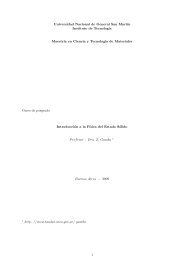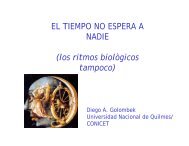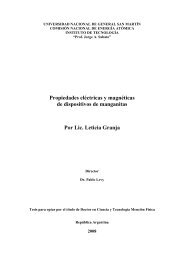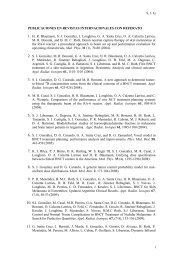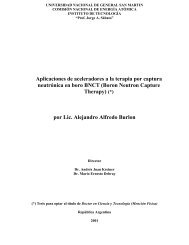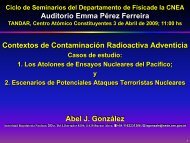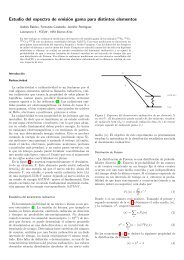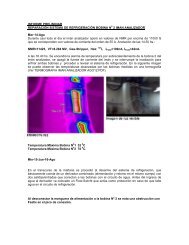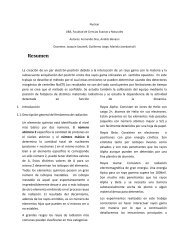Familia de Mapas del Panadero Como Ambiente Caótico de la ...
Familia de Mapas del Panadero Como Ambiente Caótico de la ...
Familia de Mapas del Panadero Como Ambiente Caótico de la ...
You also want an ePaper? Increase the reach of your titles
YUMPU automatically turns print PDFs into web optimized ePapers that Google loves.
CAPÍTULO 3. MAPA DEL PANADERO 39<br />
V<br />
000 111 1 V<br />
000000<br />
111111 2 V3<br />
V<br />
000 111 4 000 111<br />
000 111<br />
000 111000000<br />
111111000<br />
111000<br />
111<br />
000 111<br />
000 111000000<br />
111111000<br />
111000<br />
111<br />
000 111<br />
000 111000000<br />
111111000<br />
111000<br />
111<br />
000 111<br />
000 111000000<br />
111111000<br />
111000<br />
111<br />
000 111<br />
000 111000000<br />
111111000<br />
111000<br />
111<br />
000 111<br />
000 111000000<br />
111111000<br />
111000<br />
111<br />
000 111<br />
000 111000000<br />
111111000<br />
111000<br />
111<br />
000 111<br />
000 111000000<br />
111111000<br />
111000<br />
111<br />
000 111<br />
000 111000000<br />
111111000<br />
111000<br />
111<br />
000 111<br />
000 111000000<br />
111111000<br />
111000<br />
111<br />
000 111<br />
B<br />
000 111<br />
0000000000<br />
1111111111<br />
0000000000<br />
1111111111 H<br />
0000000000<br />
1111111111<br />
000000000000000000000<br />
111111111111111111111 4<br />
0000000000<br />
1111111111<br />
000000000000000000000<br />
111111111111111111111<br />
000000000000000000000<br />
111111111111111111111 H2 0000000000<br />
1111111111<br />
0000000000<br />
1111111111<br />
000000000000000000000<br />
111111111111111111111<br />
0000000000<br />
1111111111<br />
0000000000<br />
1111111111 H 0000000000<br />
1111111111<br />
0000000000<br />
1111111111 3<br />
0000000000<br />
1111111111<br />
0000000000<br />
1111111111<br />
0000000000<br />
1111111111<br />
0000000000<br />
1111111111 H<br />
1<br />
0000000000<br />
1111111111<br />
Figura 3.7: Comportamiento <strong>de</strong> 2 iteraciones <strong>de</strong>l mapa <strong>de</strong>l Pana<strong>de</strong>ro clásico. Cada una <strong>de</strong> <strong>la</strong>s regiones<br />
verticales es mapeada a una región horizontal<br />
El mapa cuántico ˆ B (2) en un espacio <strong>de</strong> Hilbert <strong>de</strong> dimensión N queda expresado en forma<br />
matricial en representación <strong>de</strong> coor<strong>de</strong>nadas como:<br />
B (2)<br />
pos = F −1<br />
⎛<br />
⎞<br />
F N 0 0 0<br />
⎜ 4<br />
⎟<br />
⎜ 0 0 F N ⎟<br />
N ⎜<br />
4 ⎟<br />
(3.40)<br />
⎜<br />
0 0 ⎟<br />
⎝<br />
⎠<br />
0 F N<br />
0<br />
4<br />
0 0 F N<br />
4<br />
En general el mapa ˆ B (T ) <strong>de</strong> l qubits, se representa circuitalmente en forma mixta como una<br />
transformada <strong>de</strong> Fourier discreta (con ángulos <strong>de</strong> Floquet) actuando sobre los T −l qubits menos<br />
significativos y un intercambio <strong>de</strong> qubits en los T qubits más significativos. Este intercambio<br />
consiste en “swaps” entre los qubits más y menos significativos, los siguientes más y menos<br />
significativos y así sucesivamente (entre estos T qubits) (ver figura 3.8).<br />
Figura 3.8: Cuantización <strong>de</strong>l mapa <strong>de</strong>l pana<strong>de</strong>ro aplicado T veces en representación mixta<br />
Po<strong>de</strong>mos notar que ˆ B (0) = ˆ1, ˆ B (1) = ˆ B y que para l qubits po<strong>de</strong>mos tener hasta el mapa ˆ B (l) .<br />
Clásicamente, el mapa <strong>de</strong>l pana<strong>de</strong>ro es equivalente a aplicar dos iteraciones y luego su inversa,<br />
T +T ′<br />
o sea, cumple con <strong>la</strong> propiedad <strong>de</strong> composición <strong>de</strong> grupo B = BT ′<br />
c<strong>la</strong>sBT c<strong>la</strong>s . En el caso cuántico<br />
c<strong>la</strong>s<br />
esta propiedad no se cumple.<br />
Po<strong>de</strong>mos pensar que todos los mapas cuánticos <strong>de</strong>l tipo ˆ B (n−1)† B ˆ(n) con n = 1, . . . , l son<br />
cuantizaciones <strong>de</strong>l mapa <strong>de</strong>l Pana<strong>de</strong>ro. Estos tipos <strong>de</strong> mapas no son más que los ya <strong>de</strong>finidos en<br />
(3.29, 3.31, 3.39), o sea, ˆ Bl,n = ˆ B (n−1)† B ˆ(n) .



